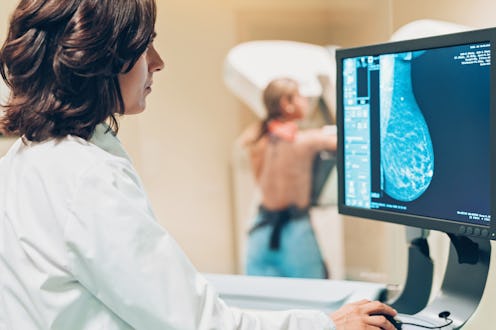Health
Here’s Why Breast Cancer Can Take A Long Time To Develop
Some tumors grow a lot faster than others.

If you've ever had an abnormal mass in your breast, or had a family history of breast cancer, you know the dread of wondering whether that lump is cancerous, and how fast it's growing. It's important to know that not all breast cancers grow in the same way. Breast cancer can develop at different speeds, experts tell Bustle, and many factors affect how fast or slow the process is.
Breast cancers happen when cells start to divide without stopping, Dr. Debra Patt M.D., an oncologist, breast cancer specialist, and executive vice president of Texas Oncology, tells Bustle. "Imagine you have a population of rabbits that doubles each month," Dr. Patt says. "In month one you have two rabbits, then four, then eight. It is a very different population at month three (eight rabbits) and month seven (128 rabbits)."
It’s important to do breast self-exams regularly (at least once a month, according to the nonprofit breastcancer.org.) Still, a cancer cell must divide around 30 times before it can be felt as a tumor, at about half an inch in diameter, according to the Robert W. Franz Cancer Research Center at Providence Portland Medical Center. But there's not a one uniform timeline for breast cancer growth.
"Breast cancer can be slow growing, aggressive, or middle-of-the-road growth," Dr. Deborah M. Axelrod M.D., a breast surgeon and professor at NYU Langone Health's Perlmutter Cancer Center, tells Bustle. On average, Dr. Axelrod says, the time that the tumor takes to double in size is between 50 and 150 days. "Fortunately, most breast cancer is not aggressive and kind of grows in the middle of the road," she says. One cell division can take up to one or two months, which means that a breast cancer tumor, even a small one, may have been quietly building for two to five years. (Again — that’s why so many medical experts recommend regular self exams. Get to know your own boobs and pay attention to any changes.)
If you're diagnosed with breast cancer, your illness will be given both a grade and a stage. Its stage, from one to four, indicates how much it's progressed and whether it's spread to other parts of your body. Its grade, from one to three, is how fast it's growing, with three being the fastest.
"Certain types of breast cancer can be known to grow more rapidly than others, such as triple-negative cancers and HER2 positive cancers," Dr. Janet Yeh M.D., a breast surgeon at NYU Langone Hospital–Brooklyn, tells Bustle. Some kinds are slower: for instance, tubular breast cancer, a cancer of the tissue ducts in the breasts that tends to be tube-shaped, usually takes a relatively long time to develop.
A 2018 study published in Breast Cancer looked at how breast tumors grew in between diagnosis and surgery, and found that 64% grew over the course of around 57 days. On average, those tumors grew by about 35%. Triple negative breast cancers, according to this study, were the most likely to be fast-growing. And a 2020 study published in The Breast showed that the younger cancer patients were, the more likely they were to have rapid-growing breast cancers.
In some people, breast cancer growth can be very slow. "A one-centimeter cancer can take 10 years to grow," says Dr. Axelrod. In others, it's rapid. And it's very hard to pin down how aggressive your cancer might be — even if family members have had fast-growing breast cancer before. "Having a family history of breast cancer or even a pathogenic gene mutation like BRCA does not mean you are more likely to have an aggressive cancer," Dr. Yeh says. "It just means you're more at risk of breast cancer in general." A lot of factors are involved in how breast cancers form and develop, including environment and age.
"It’s important to understand we still don’t know why some people who have no risk factors develop cancer, yet other people who are at high risk, do not. It is an unpredictable disease, which is precisely why people shouldn’t wait," Dr. Patt says.
A lump in your breast that appears to be growing fast might not be malignant; some benign lumps can increase in size rapidly too. Either way, if you do notice a bump that wasn't there before, it's a good idea to get to your doctor ASAP to get it checked out.
Experts:
Dr. Deborah M. Axelrod M.D.
Dr. Debra Patt M.D.
Dr. Janet Yeh M.D.
Studies cited:
Förnvik, D., Lång, K., Andersson, I., Dustler, M., Borgquist, S., & Timberg, P. (2016). ESTIMATES OF BREAST CANCER GROWTH RATE FROM MAMMOGRAMS AND ITS RELATION TO TUMOUR CHARACTERISTICS. Radiation protection dosimetry, 169(1-4), 151–157. https://doi.org/10.1093/rpd/ncv417
MacInnes, E. G., Duffy, S. W., Simpson, J. A., Wallis, M. G., Turnbull, A. E., Wilkinson, L. S., Satchithananda, K., Rahim, R., Dodwell, D., Hogan, B. V., Blyuss, O., & Sharma, N. (2020). Radiological audit of interval breast cancers: Estimation of tumour growth rates. Breast (Edinburgh, Scotland), 51, 114–119. https://doi.org/10.1016/j.breast.2020.03.006
Nakashima, K., Uematsu, T., Takahashi, K., Nishimura, S., Tadokoro, Y., Hayashi, T., & Sugino, T. (2019). Does breast cancer growth rate really depend on tumor subtype? Measurement of tumor doubling time using serial ultrasonography between diagnosis and surgery. Breast cancer (Tokyo, Japan), 26(2), 206–214. https://doi.org/10.1007/s12282-018-0914-0
This article was originally published on